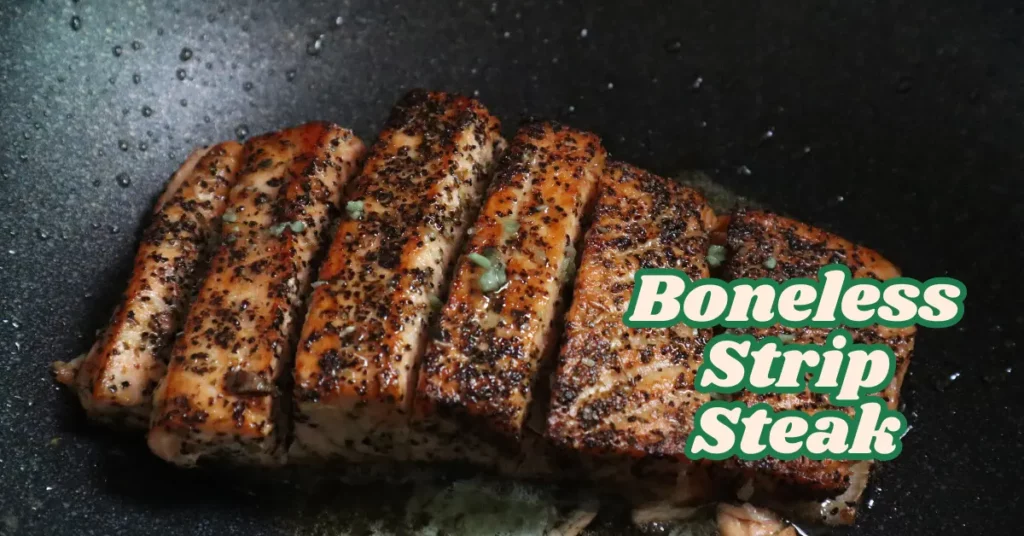This post may contain affiliate links. If you use these links to buy something we may earn a small commission. Thanks.
A perfectly cooked boneless strip steak also known as a New York strip steak is a culinary delight. Known for its balance of tenderness, flavor, and marbling, this steak is a favorite among home cooks and steakhouse chefs alike. Whether you want a quick pan-seared dinner or a reverse-seared masterpiece, mastering this cut of meat is easier than you think.
In this comprehensive guide, you’ll learn everything from how to choose the right cut to how to cook it to juicy, restaurant-quality perfection. Let’s dive in!
Choosing the Right Boneless Strip Steak
Your steak’s quality begins long before it hits the pan. Picking the right cut is the foundation of a great meal.
Grading: Understanding USDA Labels
- USDA Prime: The highest quality with abundant marbling. Ideal for maximum juiciness and flavor.
- USDA Choice: A great balance between quality and affordability. Most home cooks opt for Choice.
- USDA Select: Leaner with less marbling; not recommended unless you’re on a low-fat diet.
Marbling Matters
Marbling refers to the white streaks of fat within the muscle. More marbling equals more flavor and a buttery mouthfeel. Choose steaks with fine, even fat distribution.
Thickness
Opt for steaks that are at least 1 to 1.5 inches thick. Thicker steaks retain moisture better and allow for more control over doneness without overcooking.
Fresh vs. Frozen
While fresh steaks are preferable, frozen ones can still taste fantastic if stored and thawed properly. Avoid freezer burn and always check packaging for airtight seals.

Preparing the Steak
Before you turn on the heat, you need to treat your steak right.
Thawing
If your steak is frozen, thaw it slowly in the refrigerator for 24 hours. For quicker results, submerge it in a sealed bag in cold water for about 1–2 hours.
Bring to Room Temperature
Let the steak sit at room temperature for 30–60 minutes before cooking. This helps it cook more evenly and prevents a cold center.
Trim Excess Fat
While a little fat is desirable, excess exterior fat can cause flare-ups on the grill or uneven cooking. Trim any thick fat caps to about 1/4 inch.
Pat Dry
Use paper towels to pat the steak completely dry. Moisture on the surface will hinder browning and cause steaming instead of searing.
Season Generously
- Basic Seasoning: A liberal amount of kosher salt and freshly ground black pepper is all you really need.
- Advanced Flavors: Add garlic powder, smoked paprika, rosemary, or a steak rub for an extra punch.
- When to Season: Either right before cooking or 40+ minutes before. The middle window (10–30 mins) can draw out moisture without enough time to reabsorb it.
Optional Marinating
Boneless strip steaks don’t require marinating, but if you want added flavor, use marinades with olive oil, soy sauce, vinegar, and herbs. Marinate for 1–4 hours max.
Cooking Methods
There’s no single “right” way to cook a strip steak. Choose based on your tools and flavor preference.
A. Pan-Searing: A Classic Steakhouse Technique
This is the go-to method for many home cooks.
Steps:
- Use a heavy-bottomed cast iron skillet for even heat retention.
- Preheat the pan over medium-high heat until it’s smoking hot.
- Add a splash of high smoke point oil like avocado or grapeseed oil.
- Gently place the steak in the pan. Don’t move it around.
- Cook for 3–4 minutes per side for medium-rare, adjusting time based on thickness.
- Add butter, smashed garlic, and rosemary in the last 2 minutes and baste continuously.
- Remove from heat and let it rest.
B. Grilling: For a Smoky Char
Grilling infuses your steak with a bold, smoky flavor.
Steps:
- Preheat grill to high heat (450–500°F).
- Oil the grates to prevent sticking.
- Sear over direct heat for 3–4 minutes per side.
- Move to indirect heat to finish cooking if steak is thick.
- Use a meat thermometer to check doneness.
C. Oven-Finished: Reverse Sear Technique
This method gives you a perfectly even interior and a crisp crust.
Steps:
- Preheat oven to 250°F.
- Place seasoned steak on a wire rack over a baking sheet.
- Cook in the oven until the internal temperature reaches 10–15°F below desired doneness.
- Sear the steak in a screaming hot pan for 1–2 minutes per side to create a crust.
- Rest before slicing.
D. Sous Vide: Precision Perfection
Sous vide ensures edge-to-edge doneness.
Steps:
- Vacuum-seal the steak with seasoning and herbs.
- Set sous vide to desired doneness:
- Medium-Rare: 130°F
- Medium: 140°F
- Cook for 1–2 hours.
- Sear quickly in a hot pan or on a grill for a crispy outer crust.
Determining Doneness
The only way to guarantee perfect doneness is by using a meat thermometer.
| Doneness | Internal Temp (°F) |
|---|---|
| Rare | 120–125 |
| Medium-Rare | 130–135 |
| Medium | 140–145 |
| Medium-Well | 150–155 |
| Well-Done | 160+ |
Pro Tip: Always remove your steak from heat 5°F before the target temperature, as it will continue to cook while resting.
Resting and Slicing the Steak
Why Resting Matters
After cooking, let your steak rest for 5–10 minutes. This allows the juices to redistribute rather than spilling out onto your plate.
How to Slice
Always cut against the grain to shorten the muscle fibers and ensure each bite is tender.
Serving Suggestions
Elevate your steak dinner with the right sides and sauces.
Sides to Serve
- Garlic mashed potatoes
- Roasted asparagus or Brussels sprouts
- Baked sweet potatoes
- Grilled corn on the cob
- Caesar salad
Sauces & Toppings
- Garlic herb butter
- Chimichurri
- Red wine reduction
- Peppercorn sauce
Wine Pairings
- Cabernet Sauvignon: Bold and tannic—perfect for a rich strip steak.
- Malbec: Fruity with spice to complement grilled flavors.
- Syrah/Shiraz: Great with peppery rubs or charred crusts.
Common Mistakes to Avoid
Avoid these pitfalls to ensure a steakhouse-quality result:
- Cooking from cold: Always let steak warm up before cooking.
- Overcrowding: Don’t cram the pan or grill steak needs space to sear.
- Constant flipping: Let it develop a good crust before turning.
- Skipping the thermometer: Guesswork leads to overcooked steak.
- Cutting too soon: Resting is essential for juicy steak.
Conclusion
Cooking a boneless strip steak to perfection is a culinary skill that anyone can master with the right techniques. Whether you’re searing in a skillet, grilling outdoors, or trying the sous vide method, the key lies in preparation, temperature control, and attention to detail.
With this guide in hand, you’re ready to create a restaurant-quality strip steak in your own kitchen. So go ahead grab that steak, fire up the stove or grill, and impress your taste buds (and your guests).
